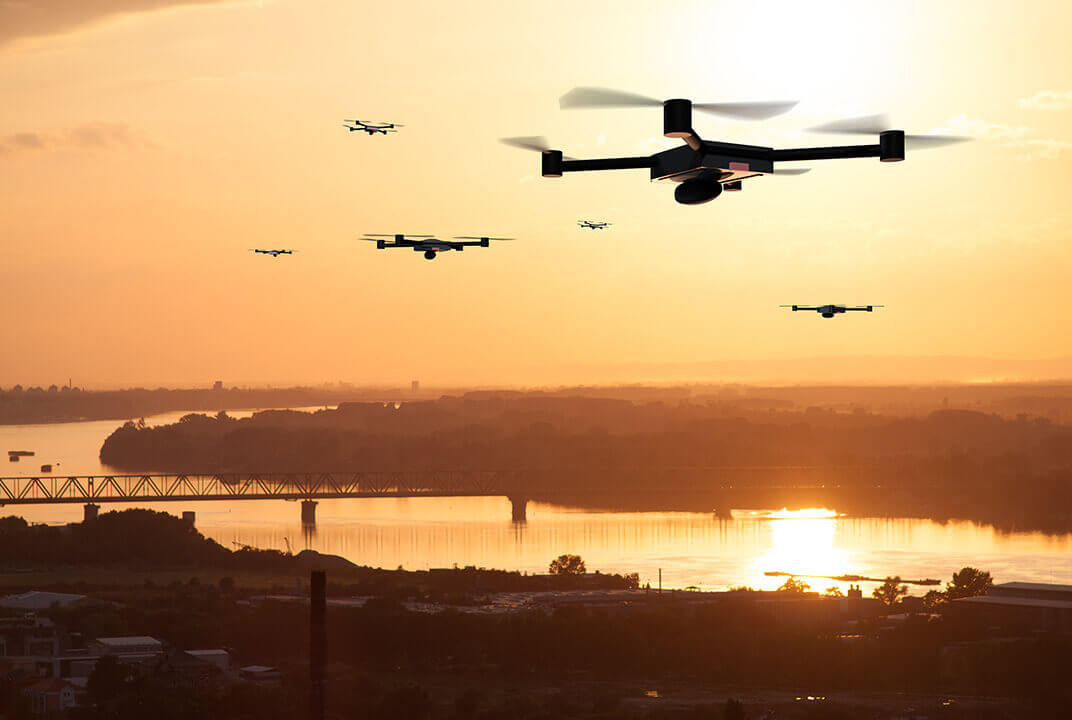Insight | Shared vision key to Harvest and Inmarsat’s fruitful partnership
Shared vision key to Harvest and Inmarsat’s fruitful partnership
Aviation
By working together, Inmarsat and Harvest are pointing towards a productive future for the UAV sector
Many factors combine to produce great working partnerships. Trust and respect are obviously critical. As is a willingness to be open; to reveal ideas and dispense of ego. Crucially, there has to be a commitment to achieve a common goal.
It’s the last element that has impressed Paul Guilfoyle, Managing Director of Harvest Technology Group, a global leader in network optimised remote operations, when discussing his company’s relationship with Inmarsat in the inventive and rapidly expanding unmanned aerial vehicle (UAV) sector.
“It’s really exciting to be working with a partner that shares the same vision and goals,” he explains enthusiastically from Harvest’s base in Perth, Western Australia. “Inmarsat is a global leader; they have been very easy to collaborate with and very open with their views. Inmarsat have brought a willingness to talk and look into the future of all its sectors, whether it be government, defence, aviation, or enterprise. That’s certainly made our engagement straightforward.”
Not only is this shared vision a crucial pre-requisite for pushing innovation – itself an integral component in the UAV sector – and the commercial opportunities that flow from these advances, but it also underpins Inmarsat and Harvest’s efforts in overcoming any regulatory barriers that might prevent the full potential of UAVs being realised.
It’s clearly something Guilfoyle and Harvest appreciate: “The only way that you can really make this [the UAV sector] mainstream is by going down the path of a ubiquitous solution. And unless it’s supported by the ultimate network provider – such as Inmarsat – it’s never going to go anywhere.”
Technology makes our lives smarter and easier – this is integral to UAVs
Harvest doesn’t build or manufacture UAVs, it doesn’t operate them or fly them. Harvest’s unique proposition, however, chimes perfectly with the unlimited potential of the UAV sector.
Fundamentally, Harvest builds and develops software and hardware that enables remote installations to be viewed and inspected from afar. These products can provide immediate feedback to a company’s HQ or base, allowing them to evaluate and make decisions in real-time, transforming how its customers carry out field operations.
Therefore, utilising UAVs and taking the human element out of that remote process is a logical fit for Harvest. Its technology protocols provide secure real-time, bandwidth-optimised, audio-visual streaming and control capabilities. For instance, this enables a UAV to produce footage that can be viewed from base locations without the necessity of a specialist having to attend or interact with the remote environment or operation.
“Technology is all about making things easier for people,” Guilfoyle points out. “And that’s what we’re trying to do at Harvest. For instance, our clients don’t have to go to different suppliers for airtime and a terminal. We bring everything together into one small package, which uses less power. That’s our goal, to be part of a complete solution.”
Ensuring technology – and data – becomes more mainstream
It wouldn’t be correct to say the Harvest and Inmarsat partnership came about by accident. Harvest was already utilising Inmarsat’s network and terminals, such as the BGAN710 Explorer, for its remote surveillance technology which is being used in energy, mining, and oil and gas industries.
There is, however, a pleasing serendipity as to how Harvest took this terminal, recognised it had spare capacity, and then hit upon the idea of using UAVs to increase their capability. Harvest commenced its trials with a Western Australian based UAV partner (OmniDrone) and Western Power.
Following a call for collaboration partners by Inmarsat on a LinkedIn post, Harvest keenly responded and the process was set in motion. As Guilfoyle notes, “moving into UAVs wasn’t by design. Being industry and asset agnostic, it gave us an opportunity to further develop the capability of our technology.”
The events of the last year or so have demonstrated that this happy accident was no fluke. In our rapidly changing world the requirement to send more and more rich data is exponentially increasing. As such, networks are becoming more congested. And while urban areas can use terrestrial networks, the majority of the planet doesn’t have access to them.
“People have to deal with satellite communications or no communications, and typically, it's expensive and uses a lot of data and bandwidth,” Guilfoyle explains. “Our journey began with solving a problem and that was how do we reduce exposure of personnel in offshore oil and gas environments. We solved this by creating a protocol that successfully transfers data from any environment over the lowest possible bandwidth and across any network regardless of congestion, whilst maintaining the highest level of security and data fidelity.”
Harvest’s ambition is to become a one-stop connectivity shop that has a simple and intuitive user experience at its core. And this is where the collaboration with Inmarsat really comes into its own. Inmarsat satcom networks allow Harvest to provide its customers with Beyond Visual Line of Sight (BVLOS) optimised connectivity whether it be sea, land, or air enabled solutions.
On top of this, there’s an expectation that the unified vision Harvest and Inmarsat are working towards will also pay dividends in the contested regulatory space. In short, allowing UAVs to realise their full potential, particularly when it comes to BVLOS and situational awareness.
The unlimited positive impact of UAVs
“A lot of claims have been made about connected technologies acting as a catalyst for the growth of the UAV market, especially when it comes to the positive impact they will have on emergency services, disaster relief, inspection and monitoring, and the like,” Guilfoyle concurs. “Alongside the services people already associate with UAVs, for example domestic deliveries, the real benefit of them, in my estimation, will be humanitarian.
“Whether it be search and recovery or the rescue of missing people or medical drops in remote locations, these require fidelity of data,” he explains. “And these things really move the dial for people, especially in Australia because we are so remote. The ability to remotely operate UAVs and saturate an area to assist search and recovery or being able to drop off critical supplies, such as first aid packages, it’s a game changer.
“In short, it’s about using technology in a smarter way and in turn making our everyday lives easier and efficient.
“For instance, why should people have to leave their families and travel 400 nautical miles off the coast to do an inspection? Why should remote communities not have fair and easy access to medical support services?” Guilfoyle asks. “These are the type of questions quality-of-life UAVs and remote operations can answer. It’s all about making technology work for people. And it’s about the ability to conduct operations and do things in remote environments without exposing people to unnecessary hazards.”
Harvest’s fruitful partnership with Inmarsat is allowing such questions to be answered.
Building a solid partnership that looks to the future
From Harvest’s perspective, the potential of UAVs, and specifically the verticals the company can expand into on the back of this potential, are unlimited. To meet this potential and offer a one-stop solution, it needs a partner it can trust and a partner that shares the same beliefs about future-proofing industry.
“The best way to approach multiple verticals is by partnering with top tier providers like Inmarsat, and also by embedding our technology into mainstream systems and making it available to all users.
“We are really excited about building and developing a solid partnership with Inmarsat,” Guilfoyle concludes. “Bringing our technologies together to enhance people’s ability to conduct operations from safe environments, as well as enhance humanitarian endeavours, are core value drivers of both companies.”


